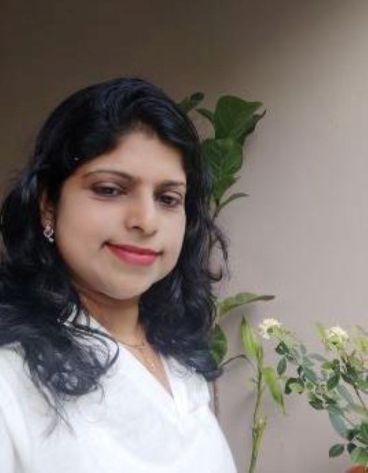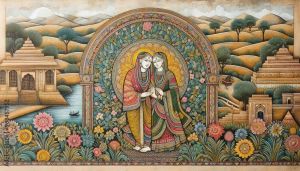
Kalamkari is an ancient fabric art renowned for its mesmerizing beauty and intricate art work. kalamkari paintings portray deities and scenes taken from the Hindu epics such as Ramayana, Mahabharata and Puranas.

Kalamkari is a well-known fabric art loved by people across the world and everyone who love Indian ethnic fashion trends collect in their wardrobe at least a kalamkari shawl. Kalamkari fascinate people owing to its bright and black intricate artworks which portray Indian mythological stories.
It is an ancient textile printing art, that originated in Machilipatnam in the state of Andra Pradesh India. The name kalamkari is derived from two Hindi words “Kalam” implies ‘pen’ and “Kari” means ‘art’, which was coined by the Mughal emperors who came across this amazing art form during their conquest extended to Deccan region.
In India, silk, mulmul, cotton, and synthetic sarees portray the kalamkari art and they have great demand locally as well as in foreign lands. Printing is a much easier task than traditional Kalamkari work. Kalamkari printed dupattas and blouse pieces are popular among Indian women particularly among urban tribes.
Genesis of Kalamkari art
Kalamkari art originated about 3000 years ago in the state of Andhra Pradesh And this art form reached the zenith of its grandeur in Andra Pradesh during the reign of Vijayanagara empire.
Kalamkari is around 3000-year-old art form as per the archeological evidence. The discovery of a resist dyed piece of cloth on a silver vase at the ancient site of Harappa (c. 2600 BC) of the Bronze Age Indus Valley Civilization corroborates for its antiquity.
Kalamkari style of art originated in Machilipatnam. Centuries ago, the artisans of the hamlets were keen to depict mythological narratives using large bolts of canvas painted on the spot with simple means and dyes extracted from plants. The depictions were linking the art with Hinduism prevailed in the land for centuries since Vedic times.
Kalamkari underwent a huge transformation in its style with the Muslim invasion in Indian subcontinent. Later the Mughal empire patronized this craft in the Coromandel and Golconda provinces. The royals called the practitioners of this craft as “Qualamkars”, from which the term “Kalamkari” has evolved.
The Pedana Kalamkari craft made in Pedana close to Machilipatnam evolved under the patronage of the Mughals and the Golconda sultanate. The original kalamkari art got influenced by Persian art under the Islamic rule. This paved way for two major styles of kalamkari art in fabrics in Indian subcontinent.
The making of Kalamkari art on fabrics
Natural dyes are used since ancient times in making kalamkari art forms. Two principal styles of Kalamkari paintings exist in India. The hand painted style practiced in the town of Srikalahasti and block printed style practiced in the town of Machilipatnam. Both styles are registered as Geographical Indications from Andhra Pradesh under handicraft goods, with the Srikalahasti style registered in 2005 and the Machilipatnam style in 2008, under the Geographical Indications of Goods (Registration and Protection) Act, 1999.
Srikalahasti style of Kalamkari
In this style of kalamkari painting the “kalam” or pen is used for freehand drawing of the subject and filling in the colors. It is entirely hand worked. It is produced in Srikalahasti of Tirupati district of Andhra Pradesh. This style flourished in temples centered on creating unique religious identities, appearing on scrolls, temple hangings, chariot banners.
Srikalahasti style of kalamkari paintings portray deities and scenes taken from the Hindu epics such as Ramayana, Mahabharata and Puranas. The Kalahasti artists generally depict on the cloth the deities, scenes from the epic Ramayana, the Mahabharata, Puranas and other mythological classics mainly producing scrolls, temple backcloths, wall hangings, chariot banners etc.
Machilipatnam style of Kalamkari or Pedana Kalamkari is vegetable dyed block-painting on a fabric. It is practiced at the town of Machilipatnam in Krishna district of Andhra Pradesh.
The captivating blend of colors on the fabrics mostly depicts characters of the Indian mythology, including the divine figures of Brahma, Saraswati, Ganesh, Durga, Shiva and Parvati.
The Machilipatnam paintings, is a melange of Hindu and Islamic art forms of fabric painting owing to the patronage of the Mughals and the Golconda Sultanate. Therefore, religious motifs of Hinduism were absent on this art form. The traditional block prints in this art show Persian motifs like interlacing pattern of leaves and flowers, the cartwheel, different forms of the lotus flower, creepers, birds like parrots and peacock, and other intricate leaf designs.
In this art form there is great significance to the portrayal of tree of life.
With the conquest by the Mughal Empire in 1687, a new style emerged in Machilipatnam kalamkari work which represented personal portraits of the emperors along with panels depicting sagas of the Mughal court.
The making of pristine kalamkari fabric
The first step in creating Kalamkari fabric is steeping it in astringents and buffalo milk and then drying it under the sun. Afterwards, the red, black, brown, and violet portions of the designs are outlined with a mordant and cloth are then placed in a bath of alizarin.
Later to cover the cloth in wax, except for the parts to be dyed blue, and immerse the cloth in indigo dye. The wax is then scraped off and the remaining areas are painted by hand.
To create design contours, artists use a bamboo or date palm stick pointed at one end with a bundle of fine hair attached to this pointed end to serve as the brush or pen. This pen is soaked in a mixture of jaggery and water; one by one these are applied, then the vegetable dyes are added.
Dyes for the cloth are obtained by extracting colours from various roots, leaves, and mineral salts of iron, tin, copper, and alum.
Various effects are achieved by using cow dung, seeds, plants and crushed flowers to obtain natural dye. Along with buffalo milk, myrobalan is used in kalamkari. Myrobalan is also used to remove the odd smell of buffalo milk. The fixing agents available in the myrobalan can easily fix the dye or colour of the textile while treating the fabric. Alum is used in making natural dyes and also while treating the fabric. Alum ensures the stability of the colour in Kalamkari fabric.
Modern day kalamkari art
Contemporary kalamkari techniques are slightly different from its primitive form. In Masulipatnam, mordant is now uniformly printed with a block. Indigo dyeing has been given up and the application of the wax resist by kalam has also disappeared. The mordant for outlining in black remains unchanged, but iron acetate has replaced indigo for dyeing the larger areas black, despite its known corrosive qualities. Yellow dyes are made from dried flowers of the myrobalam, Terminalia chebula.
Kalamkari is a vastly popularized ethnic art form which has been in use in most part of the country and spread world wide as one of the most sought-after fabric art form.
Written by Dr. Sanjana.p. Souparnika
References
- https://timesofindia.indiatimes.com/life-style/fashion/style-guide/all-about-the-famous-kalamkari-print-of-india/articleshow/101419720.cms
- https://en.wikipedia.org/wiki/Kalamkari
- https://shaza.life/blogs/news/the-art-of-kalamkari-through-the-ages
- image courtesy-https://www.freepik.com/search?format=search&last_filter=query&last_value=kalamkari+on+canvas&query=kalamkari+on+canvas

